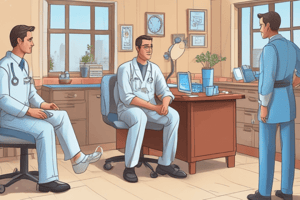Podcast
Questions and Answers
What is a common limitation of doctors in responding to patient cues?
What is a common limitation of doctors in responding to patient cues?
- They are not good at picking up cues of an informational nature.
- They are not good at observing non-verbal communication.
- They are not good at picking up cues of an emotional nature. (correct)
- They are not good at responding to verbal cues.
What type of words may indicate emotional cues in a patient?
What type of words may indicate emotional cues in a patient?
- Emotionally laden words (correct)
- Informal language
- Medical jargon
- Technical terms
Why may a patient repeat emotionally laden words?
Why may a patient repeat emotionally laden words?
- Because they want attention
- Because they are nervous
- Because they feel the doctor has not heard them (correct)
- Because they are unsure of the diagnosis
How should you respond when a patient hesitates mid-sentence?
How should you respond when a patient hesitates mid-sentence?
What is the purpose of asking questions about the patient's perspective?
What is the purpose of asking questions about the patient's perspective?
What should you do when a patient uses non-verbal cues?
What should you do when a patient uses non-verbal cues?
What is the importance of active listening in a consultation?
What is the importance of active listening in a consultation?
What skill is necessary to explore the patient's perspective further?
What skill is necessary to explore the patient's perspective further?
Which of the following is NOT a process skill for gathering information?
Which of the following is NOT a process skill for gathering information?
Which of the following is considered a part of the Patient's Perspective?
Which of the following is considered a part of the Patient's Perspective?
What does the 'open to closed cone' question style refer to?
What does the 'open to closed cone' question style refer to?
Which of the following is NOT a component of the Biomedical perspective?
Which of the following is NOT a component of the Biomedical perspective?
What is the purpose of 'time-framing' as a process skill?
What is the purpose of 'time-framing' as a process skill?
What does 'picking up cues' refer to in the context of information gathering?
What does 'picking up cues' refer to in the context of information gathering?
Why is it important to encourage the patient to express their feelings?
Why is it important to encourage the patient to express their feelings?
Which of the following is an example of 'background information' as described in the content?
Which of the following is an example of 'background information' as described in the content?
What type of questions allows patients freedom to elaborate on their responses?
What type of questions allows patients freedom to elaborate on their responses?
Which of the following is an example of a closed question?
Which of the following is an example of a closed question?
What is a characteristic of open questions?
What is a characteristic of open questions?
How do closed questions generally impact a patient consultation?
How do closed questions generally impact a patient consultation?
When would it be appropriate to use an open but specific question?
When would it be appropriate to use an open but specific question?
Which of the following leads to a more comprehensive understanding of a patient's condition?
Which of the following leads to a more comprehensive understanding of a patient's condition?
What is a limitation of closed questions?
What is a limitation of closed questions?
Which statement best describes leading questions?
Which statement best describes leading questions?
What is an effective way to begin a consultation to identify patient concerns?
What is an effective way to begin a consultation to identify patient concerns?
Which of the following techniques is crucial for active listening during a patient consultation?
Which of the following techniques is crucial for active listening during a patient consultation?
What is the goal of confirming the patient's list during a consultation?
What is the goal of confirming the patient's list during a consultation?
What impact does allowing a patient to finish their opening statement have on the consultation?
What impact does allowing a patient to finish their opening statement have on the consultation?
Which of these does NOT form part of the skills required to identify reasons for consultation?
Which of these does NOT form part of the skills required to identify reasons for consultation?
How can a physician ensure that a patient fully expresses their problems during a consultation?
How can a physician ensure that a patient fully expresses their problems during a consultation?
What is the potential risk of interrupting a patient during their opening statement?
What is the potential risk of interrupting a patient during their opening statement?
What should be prioritized after asking an opening question in a patient consultation?
What should be prioritized after asking an opening question in a patient consultation?
What are the four key components necessary for a successful clinical consultation?
What are the four key components necessary for a successful clinical consultation?
Why are communication skills important in a clinical setting?
Why are communication skills important in a clinical setting?
What does the Calgary-Cambridge Guide primarily emphasize in medical consultations?
What does the Calgary-Cambridge Guide primarily emphasize in medical consultations?
Which statement best reflects the relationship between the components of a clinical consultation?
Which statement best reflects the relationship between the components of a clinical consultation?
What type of scenarios are used in Clinical Skills training?
What type of scenarios are used in Clinical Skills training?
In what way does the Calgary-Cambridge Guide relate to emerging evidence in medicine?
In what way does the Calgary-Cambridge Guide relate to emerging evidence in medicine?
What must be present in a consultation even if a patient appears well?
What must be present in a consultation even if a patient appears well?
What is the contribution of the Calgary-Cambridge team in medical education?
What is the contribution of the Calgary-Cambridge team in medical education?
Study Notes
Identifying the Reason for Consultation
- The skills required to identify the reason for consultation include:
- Asking an open question to begin the interview
- Listening actively and encouraging the patient to complete and expand on their opening statement
- Confirming the patient's list
- Screening for further problems
- Agenda setting
Opening Question
- Start the consultation with an open question that allows the patient to speak freely without limitations or assumptions
- Examples of opening questions:
- "Why have you come to see the doctor today?"
- "How can I help you today?"
- "What do you want to see the doctor about today?"
Active Listening
- Listen attentively to the patient's opening statement without interrupting or directing their response
- Use non-verbal communication to show genuine interest and encourage the patient to elaborate
- Avoid interrupting the patient, as research shows that patients are more likely to present more of their problems to the doctor if they are not interrupted
Process Skills and Content
- Process skills are the techniques used to gather information
- Content refers to the biomedical, patient perspective, and background information that the doctor needs to gather
- Gathering information involves:
- Patient narrative
- Question style: open to closed cone
- Attentive listening
- Facilitating response
- Picking up cues
- Clarification
- Time-framing
- Internal summary
- Appropriate use of language
- Additional skills for understanding the patient's perspective
Content of Information Gathering
- History of the Presenting Complaint
- Biomedical perspective (disease)
- Sequence of events
- Symptom analysis
- Relevant systems review
- Patient's perspective (illness)
- Ideas and beliefs
- Concerns
- Effects on life
- Patient is encouraged to express feelings
- Biomedical perspective (disease)
- Background information
- Past medical history
- Drug and allergy history
- Family history
- Personal and social history
- Review of systems
Types of Questions
- Open questions:
- Often start with what, when, where, how, and why
- Encourage a response that can provide a range of information
- Do not limit the response to a "yes" or "no"
- Examples:
- "Tell me about that cough"
- "What's been going on with that cough?"
- Closed questions:
- Generally lead to a one-word answer, usually "yes" or "no"
- Do not encourage elaboration
- Examples:
- "Do you have a cough?"
- "Do you cough at night?"
Non-Verbal Cues and Emotional Cues
- Non-verbal cues:
- Looking anxious or showing worry in body posture, facial expression, and tone of voice
- Recognize and follow up on these cues
- Emotional cues:
- Use of emotionally laden words like "worried", "anxious", "frightened", "dangerous", "important", "serious", or "stressed"
- Follow up on these cues to show empathy and build rapport
Building the Relationship
- Ask direct questions to explore the patient's perspective further
- Follow up on cues that the patient gives
- Recognize and respond to informational and emotional cues
Studying That Suits You
Use AI to generate personalized quizzes and flashcards to suit your learning preferences.
Related Documents
Description
This quiz assesses skills required to identify the reason for consultation in a medical setting, including asking open questions, active listening, and agenda setting. Test your knowledge of effective patient consultation techniques!




